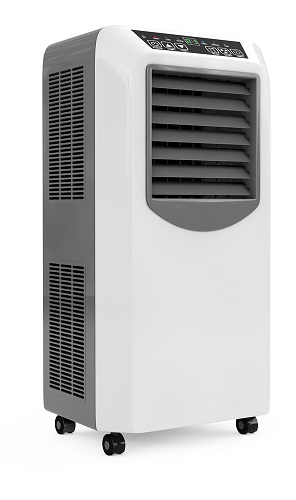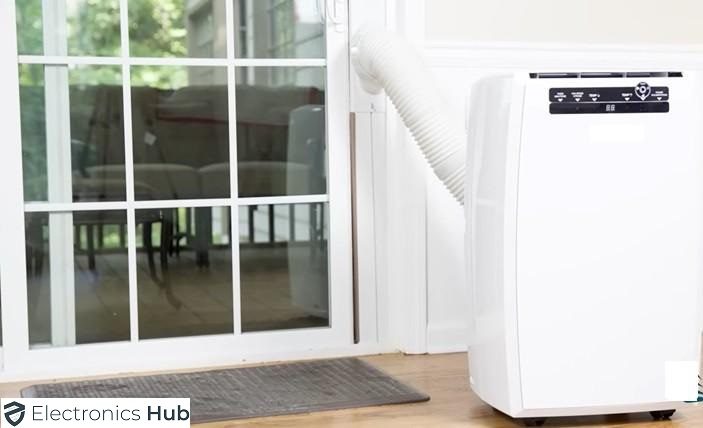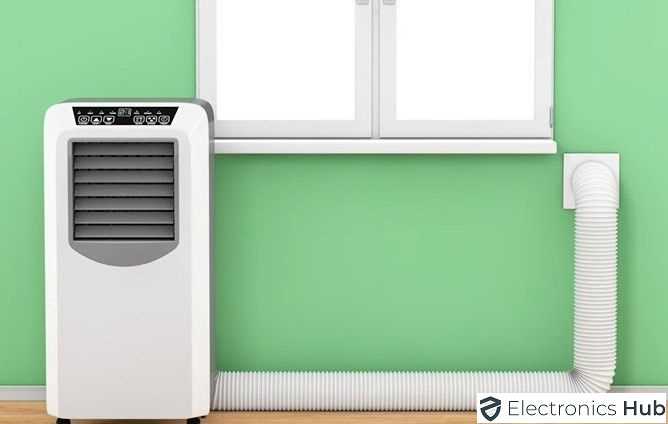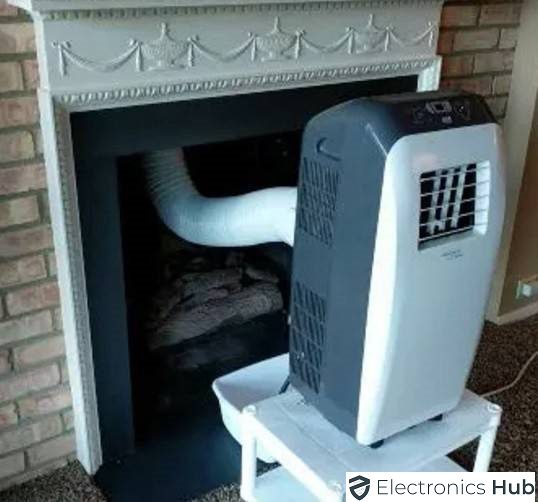If you own a portable AC, you must figure out how to vent it without a window. You don’t need to worry—we’ve got you covered here! For portable ACs to work properly, adequate ventilation must be crucial in spaces without windows.
You have a few choices, like employing a drop ceiling, sliding glass door, or a dryer vent. Keep reading for a thorough explanation of how to vent your portable AC unit without a window.
Outline
Toggle- Working Mechanism Of A Portable AC
- Why Is It Necessary To Vent Your Portable AC?
- How Will You Vent Portable AC Without A Window?
- 1. Sliding Door AC Venting
- 2. Wall Venting For AC Units
- 3. Ceiling Venting For Your Portable Air Conditioner
- 4. AC Venting Through A Dryer Vent
- 5. AC Venting Through An Unutilized Chimney
- 6. Venting An AC Via A Wall Outside
- 7. Vent A Portable AC Unit Through Your Interior Wall
- 8. Casement Windows For AC Ventilation
- What Alternative Means Are There To Vent The Portable AC?
- FAQs:
- Conclusion
Working Mechanism Of A Portable AC
Without the necessity for permanent installation or the cost of a centralized AC structure, portable air conditioners are an easy method to cool down any space. They function by drawing hot air out of the space, chilling it, and then recirculating cool air into the area. Let’s examine the operation of portable air conditioners in more detail.
A compressor, condenser, evaporator, and fan are the four essential parts of a standard portable air conditioner. Together, these elements chill the air in the space.
Do you want to know how it works? Check out the following steps:
- Air intake: The procedure begins when your portable AC system uses a fan to suck hot air out of the space. Hot air is drawn into the device via the machine’s side or back air inlet vent.
- Cooling: The warm air is then circulated over the liquid-filled evaporator coils. As a result of absorbing the heat from the heated air, the refrigerant liquid transforms into a gas. The air is thus cooled, and the device pumps the chilled air back through the space.
- Condensation: Once the refrigerant gas gets heated, it travels via the compressor, compressing it and increasing the gas’ temperature. The condenser coils found on the external surface of your portable AC unit are subsequently subjected to hot, pressurized gas. The refrigerant gas changes again into a liquid condition as a result of the condenser coils discharging heat into the environment.
- Cycle repetition: The cycle is repeated by pumping the refrigerant liquid back into the evaporator coils to begin the procedure. The space is kept cozy and cool by drawing in hot air, chilling it down, and exhaling hot air outside your machine.
- Ventilation: When utilizing a portable air conditioner, ensuring enough ventilation is crucial. Condenser coils generate hot air, which ought to be evacuated outside. The exhaust line included with most portable air conditioners must be linked with a window or vent to expel the hot air outdoors.
Why Is It Necessary To Vent Your Portable AC?
Appropriate airflow is essential for a portable air conditioner to operate efficiently and cool the room. With sufficient venting, the efficiency of the AC unit may be increased, leading to a more relaxing indoor atmosphere. Listed below are a few justifications for why a portable AC needs to be vented:
- Cooling: Ventilation is required for your air conditioner to complete its primary duty of cooling the space. The room’s extracted hot air can only be released with sufficient airflow, preventing your space from cooling.
- Energy Efficiency: Effective ventilation significantly contributes to the energy utilization of the air conditioner. It’s more straightforward for the machine to chill the air once the warm air has been eliminated from the space, indicating that it won’t have to operate very hard and will use less energy, decreasing your monthly energy costs.
- Controlling humidity: Portable air conditioners assist in lowering indoor humidity conditions. The moisture within the air condenses into water molecules which you have to eliminate once the hot air is taken into the appliance and cooled. Your room’s humidity level will rise when the hot air isn’t vented outside, increasing the risk of causing harm to the walls, furnishings, and other possessions.
- Longer Lifespan: Venting further contributes to the mobile air conditioner’s extended service life. The compressor may overheat and sustain deterioration or possibly fail if the warm air isn’t evacuated outdoors. This can shorten the unit’s durability over time by causing lasting impairment to the device.
- Safety: Ventilation is also required for safety concerns. Suppose the heated air and humidity from portable air conditioners aren’t efficiently vented outdoors. In that case, they may produce a favorable atmosphere for the growth of mold and mildew, which is terrible for your well-being. Additionally, the hot air may raise the room’s temperature, which could cause discomfort, heatstroke, or heat exhaustion.
- Aesthetics: Venting the portable AC unit outdoors may also enhance the room’s looks by avoiding the setup of fixed air conditioning equipment or ducting that could disturb the interior décor or consume space. A short, discrete pipe that you can readily hide or cover up often makes up the portable air conditioner vent kit, giving the area an aesthetically appealing and smooth appearance.
Hence, proper venting is essential for your portable air conditioner to work safely and efficiently. Therefore, vent it properly to get the most from your portable AC unit.
How Will You Vent Portable AC Without A Window?
Because there are no windows in your room, are you having trouble figuring out how to vent your portable air conditioner correctly? Although it could seem like a complex undertaking, there are a number of strategies you can take into account depending on your unique needs and the restrictions of your living area.
1. Sliding Door AC Venting
Venting a portable air conditioning unit through sliding doors can be a practical solution for those who lack traditional windows or have irregular window sizes. This is how you need to do it:
- First, open your sliding door and determine the opening’s height and width.
- Buy a sliding door vent assembly the right size for opening your door. In these kits, you’ll often find a vent panel that slides into your door track, plus a vent hose that fastens to the panel.
- Now, insert the vent panel into your door track, then snugly adjust it to match the aperture.
- Link the air conditioner’s vent hose to the panel by attaching it there.
- You can cover all openings using duct tape or a sealant kit to stop air leaks around the panel.
Sliding door vent kits are simple to set up and are easily accessible online or in local hardware stores. They are a practical solution for venting portable air conditioners and are simple to eliminate when out of operation.
2. Wall Venting For AC Units
Venting a portable air conditioner through a wall may prove a valuable and efficient approach when conventional venting methods like windows or sliding doors are not accessible. This is how you do it:
- Assess the length of your vent hose plus the closeness to its electrical socket when choosing a place for the air conditioner.
- You must mark the spot where you’ll cut a hole in your wall. It’s critical to pick a spot without pipes or power lines.
- You may use a hole or reciprocating saw to make a hole in your wall.
- Next, connect the vent hose to the air conditioner’s rear and feed via the opening.
- Cover the hole with an outside vent cap to keep rain and pests out.
- Fill up any holes surrounding the vent and cover it with caulk or weather-stripping to stop air leakage.
When your wall is bearing loads or has any plumbing or electrical considerations, venting a portable air conditioner via a wall may necessitate an expert installation.
3. Ceiling Venting For Your Portable Air Conditioner
For people who don’t have access to conventional window or wall venting alternatives, venting through the ceiling may be a viable option. You should proceed as follows:
- Assess the opening size after removing the cover from your ceiling vent.
- Now, bring a vent hose that is the exact size of the hole.
- The AC unit’s rear must be connected to your vent hose next.
- Insert this vent hose via the ceiling vent aperture, then firmly fasten it to the vent covering it using screws or duct tape.
- Finally, turn on your cooling unit and check for air leaks near the vent cover.
Because warm air rises while cool air typically sinks, it’s crucial to remember that there may be more effective choices than venting a portable air conditioner into a ceiling vent. This can cause the cool air to be distributed in the room unevenly.
4. AC Venting Through A Dryer Vent
If you don’t have access to any windows or sliding doors yet possess a dryer vent in your home, you may be capable of venting a portable AC unit through it. How to do it is as follows:
- First, take the dryer vent off the wall.
- Next, fasten the dryer vent aperture to the vent line from your portable cooling system. Applying duct tape or a vent hose connection will do this.
- Now, switch on your AC, scanning for any signs of air leakage around the vent hose.
- You can caulk or use weather stripping to fill gaps and stop air leakages surrounding the vent pipe.
It’s crucial to remember that venting a portable air conditioner via a dryer vent may not represent the most effective choice because dryer vents are usually made for hot air venting and cannot accommodate the amount of air expelled by the air conditioning unit. Furthermore, when the dryer vent isn’t regularly cleaned and preserved, this technique might not be appropriate because lint buildup could pose an ignition risk.
5. AC Venting Through An Unutilized Chimney
If you have a non-working chimney, venting a portable air conditioner through it is an unusual alternative. This is how you do it:
- You need to ensure no blockages or dirt obstruct the airflow by cleaning the chimney.
- Evaluate the chimney aperture’s dimensions to ensure the vent hose from the air conditioner fits correctly.
- You need to connect the vent hose to the back of your air conditioner.
- Push the vent hose into the chimney’s opening to vent your portable air conditioner. Now, firmly fasten it utilizing screws or duct tape.
- Look for any signs of air leakage at the chimney hole after turning on the air conditioner.
Since chimneys are made to vent hot air and could be incapable of handling the quantity of air being expelled through the AC unit, it’s vital to realize that there may be more effective alternatives than venting a portable cooling device through an unoccupied chimney. Furthermore, if the chimney isn’t regularly maintained and cleaned, this approach could not be secure because material buildup can be a fire threat.
6. Venting An AC Via A Wall Outside
Those without accessibility to a window or sliding door can vent a portable air conditioning unit via an exterior wall.
- Firstly, you must select a good spot on the exterior wall to vent your air conditioner there.
- Then you must cut a hole in the exterior wall the same size as the air conditioner vent hose.
- The AC unit’s rear must be connected to your vent hose next.
- Insert the vent hose through the wall’s hole and securely fasten it with screws or duct tape.
It’s essential to remember that while venting a portable air conditioner via a wall, the outer wall needs to be precisely cut and shut to prevent damage or leaks. In addition, this method might not be helpful for people who reside in flats or other rental buildings because it may go against building regulations or lease agreements.
7. Vent A Portable AC Unit Through Your Interior Wall
If you don’t have access to a sliding door or window and are unwilling to create a hole in your outer wall, you may be able to vent your portable AC into an inside wall. You have to do it as follows:
- You must first choose where on an interior wall to vent the air conditioner.
- Now, cut a hole in the inside wall that is identical in size to the air conditioner vent hose.
- You need to connect the vent hose to the back of the air conditioner.
- Put the vent hose through the wall’s hole and fasten it firmly with screws or duct tape.
- Cover the opening with an interior vent cap to stop air leaks and enhance the appearance of the space.
To guarantee that your wall is correctly cut and sealed to avoid any harm or leaks, it’s crucial to remember that venting a portable air conditioner via an internal wall may necessitate professional assistance. Furthermore, this approach might not be helpful for those who live in apartments or other rental properties because it might be against building regulations or lease agreements.
8. Casement Windows For AC Ventilation
If you have casement windows rather than windows that slide up and down, you can vent a portable air conditioner through them. What to do is as follows:
- Place a panel of plexiglass across the window opening. You must size the panel to fit the window opening and include a hole cut out for the air conditioner vent pipe.
- You must connect the vent hose to the back of the air conditioner and connect it to the vent hose.
- Put the vent hose via the plexiglass panel’s hole and fasten it firmly using screws or duct tape.
- Close the window above it to hold the plexiglass panel in place.
- You must weather-strip or caulk any openings around the plexiglass panel to stop air leaks.
It’s crucial to remember that not all casement windows will work well for venting a portable air conditioner. The plexiglass panel might not fit snugly or be strong enough to support the air conditioner’s load.
What Alternative Means Are There To Vent The Portable AC?
There are a few additional techniques to vent a portable air conditioner in addition to the ones already mentioned. Below are a few more choices:
- Drop Ceiling: If your room has a drop ceiling, you can place a vent in the ceiling to vent your portable AC. The vent permits the air conditioner’s hot air to get out and head toward the attic.
- Attic: If you have an attic, you may vent your portable air conditioner there. To let the hot air out, merely drill a hole in your ceiling, installing a vent.
- Ductwork: You may use an adapter kit to link the portable air conditioner to the ductwork if your home has cooling and heating systems that use ductwork. As a result, the home’s ducts can be used to vent the heated air outside.
- Portable AC Exhaust Fan: The vent pipe could be extended further than expected. One can do so with the help of portable AC exhaust enhancements, which certain companies sell. Because of this, you have more flexibility in where you can put the air conditioner.
While these methods could be effective, they might also require additional equipment. They can only be suitable for specific homes or situations. Before choosing a venting strategy for your portable air conditioner, it’s essential to consider your home’s particular needs and restrictions.
FAQs:
Technically, yes. You can create a temporary seal around the door with a panel and vent hose attachment. However, this isn’t ideal. It’s inconvenient, reduces cooling efficiency, and might damage the door. Explore other options if possible.
Venting through a drop ceiling might be manageable, especially with a vent kit. Wall venting is a more complex process that might require professional help to ensure proper installation and avoid damaging your structure.
While you’ll create a hole for the vent hose, most portable AC hoses are relatively small. You can cover the exterior vent opening with a decorative vent cover to minimize the visual impact.
Yes, some manufacturers offer extension hoses for portable AC units. However, excessively long hoses can reduce cooling efficiency. Aim for the shortest possible hose length for optimal performance.
Ventless ACs are an alternative, but they work differently. They cool by using evaporation and require emptying a water collection tank regularly. They are typically less powerful than vented ACs and might not be suitable for large spaces.
Conclusion
Even though it can seem complicated, venting the portable AC without a window is doable with the proper knowledge and tools. Furthermore, there are other ways to vent a portable air conditioner. You have various options to pick from based on the type of your room and the presence of doors or windows.
It’s essential to choose a venting method that is safe and suitable for your specific situation and to follow the manufacturer’s setup and maintenance instructions. You can maintain a comfortable inside temperature even without a regular window by adequately venting your portable AC.






